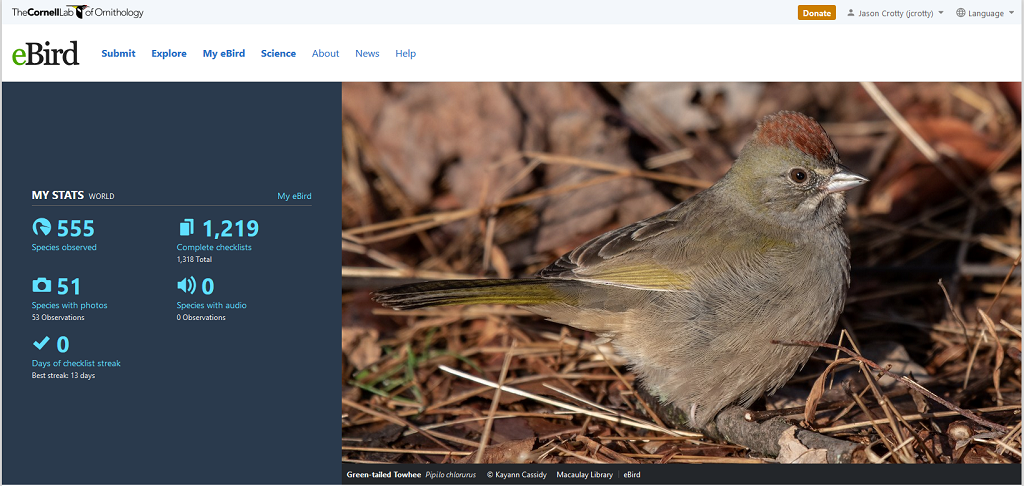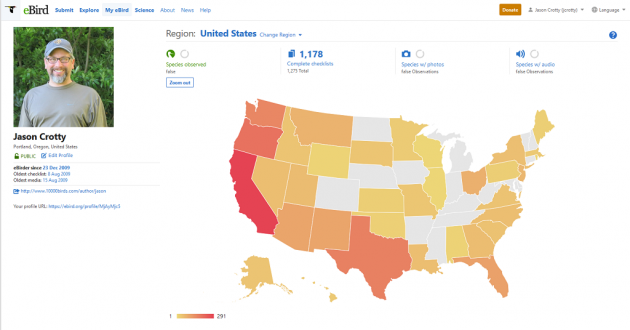
According to eBird, I have been an eBirder since December 23, 2009, so today is my 10th eBird anniversary. During the decade, I submitted 1,219 checklists and observed 555 bird species, all in the U.S. and Canada.
I started eBirding about the same time I started birding, and I made an early executive decision (a very good one) that any pre-eBird observations simply did not count. In other words, eBird is effectively a complete history of my birding experiences. Indeed, eBird is the only way I track my observations and the app is the only way I enter checklists from the field.
Because eBird has so much data that can be organized and displayed in so many ways, it is easy to find fascinating information. Accordingly, it is leaps and bounds beyond any paper-and-pencil method.
One way to view the data is to organize your “World Life List” by date. After an initial period when all species are new, the lifers begin to follow a pattern. Local birds are quickly observed, so big additions to the list are invariably made during travel.
Thus, I can pinpoint my first pelagic trip, as it added 13 new species. There’s the first meaningful trip away from the west coast: a checklist from City Park in New Orleans that added 10 new birds during a trip to see Michigan play in (and win) the Sugar Bowl. A checklist from Rock Creek Park in Washington D.C. was good for 11 lifers. Our honeymoon in the U.S Virgin Islands (St. John and St. Thomas) was good for 26 lifers. Birding trips to Florida, New Mexico, and Texas are obvious too. A pelagic out of Hatteras, North Carolina, the Biggest Week in American Birding in Ohio, and trip to Puerto Rico stand out as well.
Naturally, a walk through one’s life lists triggers memories. For me, there was the Limpkin in Loxahatchee NWR in Florida, the Atlantic Puffin at Petit Manan NWR in Maine, the Falcated Duck at Colusa NWR in California. And pretty much any American Dipper, but particularly two at incomparable locations: Yosemite NP and Yellowstone NP.
Clicking the “View All” link for any particular species on one’s Life List brings up all observations for that species. So it if you’ve even wondered how many of your checklists included at least one Mallard, this is the place. I’ve submitted 448 such checklists. On the other end of the spectrum, I’ve only had one checklist for both Mountain Plover and Northern Goshawk, among many others. Of course, you can use the data in many ways. For example, I’ve seen Bald Eagles in 15 states.
It is worth pausing to marvel at the comprehensiveness and accessibility of eBird information. In just a few clicks I can determine that my 442nd Mallard sighting was a group of 50 at Steigerwald Lake NWR on October 25, 2019, that the checklist was started at 9:46 a.m. and concluded one hour and 26 minutes later, having covered 2.57 GPS-tracked miles. The notion that such information could provided (at no cost) to any birder in the world would have been dismissed as fantastical not long ago.
Clicking “Manage My Locations” pulls up a searchable list of personal personal and hotspots. It can be viewed in many ways (e.g., by country, state, or county), including by number of checklists. The places I expected (Pillar Point Harbor in California and Ridgefield NWR in Washington) are right at the top of the list, but even places I thought I’d been to countless times have modest numbers. And there are many locations with just one or two checklists, likely a common occurrence for a traveling birder.
Of course, my Profile Page allows me to see this information in yet another way, via a color-coded map that allows me to look globally, by country, by state, and by county. Since virtually all of my birding to the United States, that’s the map I look at most. Predictably, the states I have lived in (California and Oregon) have the most species, as does nearby Washington. Texas and Florida round out the Top 5.
10,000 Birds also has an eBird profile and since I as a beat writer in 2016, I have been a part of that group. I don’t think I have added any new species, but I did add Alaska, Kansas, and Oklahoma to the group state list.
Ten years seems like a good time to look forward as well. My profile page identifies the states that I have not eBirded, including Nebraska, North Dakota, Michigan, Mississippi, and Vermont. And I will continue my quest to see all of my Top 25 National Wildlife Refuges for Birding too.
Even though I don’t have much birding outside of eBirding, it is clear that eBird has dramatically changed birding and I appreciate and value its role in my birding. eBird keeps track of all my information, allows countless ways to organize and visualize my data, and provides real time access from anywhere in the world. It continues to roll out new functionality. Moreover, it contributes to science (and economics) and the price is right.
In 2019, it is hard to imagine birding without eBird.












Agreed. You and I seem to enjoy browsing our lists and reliving the many highlights, which strikes me as one of the best reasons to list in the first place. eBird does an outstanding job of keeping old lists current and integrated with today’s taxonomy and tallies. Anyone who still keeps records on a static platform (like my old Excel lists) could do worse than to resolve to get modern in the new year.